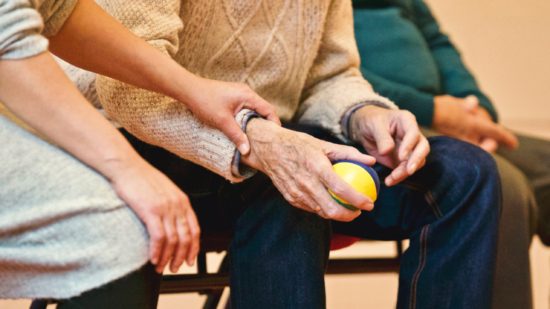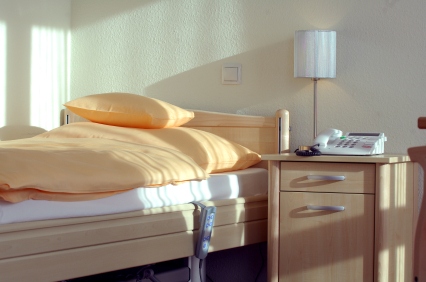Category: Depression/Mental illness/Substance Abuse
Posted by Dr. El - December 3, 2019 - Business Strategies, Depression/Mental illness/Substance Abuse, McKnight's Long-Term Care News

According to researcher Julianne Holt-Lunstad of Brigham Young University, loneliness has a greater impact on health than smoking 15 cigarettes daily, or obesity, which is associated with 300,000 to 600,000 deaths a year in the United States alone.
In England, the “loneliness epidemic” has reached such proportions that they’ve appointed a Minister for Loneliness to address the problem.
This idea led me to consider the benefits of designating such a position in long-term care. Yes, we have recreation departments that encourage resident socialization, but a Minister for Loneliness could do so much more. The Minister also could target staff loneliness and the isolation of those in the community.
Minimizing staff loneliness has the potential to reduce turnover, alleviate staff stress and improve the culture of the organization. Seeking to decrease the isolation of those in the neighborhood would enhance the reputation of the facility as a community player and create a way for locals to connect with the home before they need it, so that it becomes a natural choice for later care.
Below are some ideas of ways in which the Minister for Loneliness could affect change (but there doesn’t need to be a formal role to try these suggestions).
For residents and their families, the minister could:
- Establish a communal table for residents interested in engaging with peers for a particular meal.
- Ensure that residents who needed hearing aids and other assistive devices had fully functioning equipment available.
- Train staff to facilitate like-minded friendships between residents, seating them together at meals and during activities.

Posted by Dr. El - November 19, 2019 - Business Strategies, Depression/Mental illness/Substance Abuse, McKnight's Long-Term Care News

With trauma-related F-tags beginning in less than two weeks, many providers have spent months training their staff and feel quite prepared to manage this sensitive aspect of resident mental health care.
For those who might not be completely ready for the Nov. 28 start date, I offer below some basics on trauma-informed care practices. While none of us know exactly how the survey process will play out, these fundamentals can make it less likely to run afoul of regulations.
The Concept
The general idea of trauma-informed care is that residents who have had exposure to trauma can experience increased sensitivity to interactions in the long-term care setting that “trigger” old feelings and reactions. For instance, Bob, a resident who was physically assaulted several years ago, feels very unsafe and distressed when other residents become agitated.
The Symptoms
An individual who has experienced trauma may have symptoms of Post-Traumatic Stress Disorder (PTSD), such as an exaggerated startle response or repeated intrusive thoughts of the event. Using our example above, Bob shouts loudly in alarm when other residents are noisy or frightening, showing an exaggerated startle response.
The Goal
The new F-tags are an effort to increase awareness that the nursing home environment can trigger past experiences of trauma or exacerbate current traumas and to encourage facilities to make every effort to avoid re-traumatization.
The Interview
The first step in complying with the regulations is to determine whether or not a resident has a current or past experience with trauma. The challenge of the interview is to avoid the possibility that the manner in which the questions are asked becomes traumatizing in and of itself.
To minimize this possibility, hold the interview in as private and discreet a manner possible and “normalize” the process, explaining to interviewees that all residents are being asked about their past experiences.
Increase the interviewee’s sense of control by offering them the option not to answer any items if they feel uncomfortable.

Posted by Dr. El - October 22, 2019 - Depression/Mental illness/Substance Abuse, McKnight's Long-Term Care News


Centers for Medicare & Medicaid Services directives ask facilities to be more attentive to behavioral health issues such resident depression and trauma, and to manage dementia and other behavioral problems while reducing or eliminating psychotropic medications. Providers wondering how to accomplish this tall order might consider turning to a generally overlooked resource — their residents.
Don’t get me wrong. I firmly believe that past traumas, long-standing mental health problems, and depression and anxiety triggered by the tumult of admission should be addressed by mental health professionals such as consulting psychologists like me.
Just as firmly, however, I know that positive connections between residents can alleviate many of the problems associated with physical decline and institutional living.
Shared friendships can give meaning, purpose and joy to the lives of elders, including those with advanced dementia. I know I’m not the only one in the field who has witnessed nonsensical conversations between two confused elders who delight in each other’s presence — and the challenges that come when one of the pair departs.
Moreover, just this week McKnight’s wrote about a study reporting on the success of a peer mentoring program between residents. The “Java Mentorship” offered residents weekly training sessions incorporating 26 different modules, including “how to be a mentor” and “how to support someone who’s grieving.” When they completed the educational program, the trainees visited with other residents who were socially isolated. At the conclusion of the program, the mentors — mostly women about 80 years old — showed significantly reduced feelings of depression and loneliness.
For the entire article, visit:
Posted by Dr. El - August 27, 2019 - Boomers, Depression/Mental illness/Substance Abuse, McKnight's Long-Term Care News, Resident care, Younger residents

As I discussed in Severely mentally ill residents: A ‘perfect storm’ creates a SNF wave, long-term care has a growing population of severely mentally ill (SMI) residents, with the number of residents diagnosed with schizophrenia or bipolar disorder approaching 20% in some states as of 2017.1
In addition, 46.3% of LTC residents were diagnosed with depression in 2015 and 2016.2 Some were undoubtedly individuals with severe, chronic depression.
People with SMI generally enter nursing facilities for rehabilitation following a fall or some other health crisis. Discharge choices can be limited due to coexisting medical and mental health problems, leading them to become long-term residents despite their relatively young age (an average age of 62 versus 77 in the general nursing home population3).
A review of research on individuals with mental health problems, Physical illness in patients with severe mental disorders, finds that people with SMI have a greater likelihood of physical illness than those without SMI. The authors of the study note that “important individual lifestyle choices, side effects of psychotropic treatment and disparities in health care access, utilization and provision…contribute to these poor physical health outcomes.”
Their research suggests multiple points at which long-term care providers can intervene to assist SMI residents.
Medical assessment
Nurses and physicians can be taught to recognize health problems typical of the SMI population so that they’ll be alert to the increased risk of illnesses such as diabetes, metabolic syndrome, obesity-related cancers, cardiovascular diseases, osteoporosis, hepatitis B/C, tuberculosis, impaired lung function, poor dental status and other concerns.
Staff members who are comfortable physically assessing older residents might need additional training to be at ease evaluating SMI individuals, who may be more physically imposing because of their relative youth, come across as unfamiliar or frightening in their presentation or be themselves uncomfortable with medical tests or interventions.
For the entire article, visit:
Posted by Dr. El - June 6, 2019 - Depression/Mental illness/Substance Abuse, McKnight's Long-Term Care News, Stress/Crisis management

Here’s my latest article on McKnight’s Long-Term Care News:

Last week, New Zealand passed the country’s first “well-being budget,” with billions in funding directed towards mental health, suicide prevention, addiction treatment and combatting poverty. This development had me considering what a “well-being budget” would look like in long-term care facilities.
Reducing financial hardship
Combating poverty in nursing homes would have to address adequately funding treatments so that facilities are bringing in enough money to cover the expense of services as well as to manage upkeep and comply with regulations. It’s difficult for a business to engender well-being when under the threat of insolvency.
At the same time, any effort to reduce poverty in long-term care would certainly require living wages and reasonable benefits for workers at all levels. That would make it more likely that facilities could attract and retain capable staff.
A well-being budget would also need to increase the Personal Needs Allowance (PNA) of residents to account for inflation. While a few states have provided modest increases in resident’s monthly allowances over the years — with Florida the trailblazer at $130 – most have remained the same for decades1. In my state, New York, for example, the PNA was set at $50 in 1980. Adjusting for inflation would make New York’s PNA $155 in 2019, a more reasonable amount considering that residents are responsible for paying for their own clothes, haircuts, telephones and other personal items and have become impoverished in order to qualify for Medicaid. Sadly, however, it is still $50.
Worker well-being
To improve the mental health of those who live in nursing homes, my well-being initiative would first tend to the mental health of those who work in long-term care. If employees aren’t emotionally well-balanced, it’s much more difficult for their charges to be.
For the entire article, visit:

Posted by Dr. El - February 17, 2019 - Depression/Mental illness/Substance Abuse, McKnight's Long-Term Care News, Medication issues

Here’s my latest article on McKnight’s Long-Term Care News:

Despite the fact that my search for column inspiration took place at 3 a.m., I chose the topic of sleep deprivation because residents regularly tell me about their own sleep disturbances. They also discuss their pain.
Though their aches often keep them up at night, a January 2019 article in the New York Times, “Why It Hurts to Lose Sleep,” suggests that there’s a more complicated relationship between sleep and pain.
Author Benedict Carey described research finding “that a single night of sleep deprivation reduced a person’s pain threshold by more than 15 percent.” In addition, “small deviations in the average amount of sleep from one day to another predicted the level of overall pain felt the next day.” Staying up all night — which has been known to happen in the long-term care setting — increased pain sensitivity by 15% to 30%.
This interaction between sleep and physical discomfort is particularly relevant to those of us working in eldercare. Increased use of pain medications not only raises pharmacy costs, but can lead to a host of other problems, including constipation, daytime drowsiness, increased fall risk, the possibility of addiction, medication interactions, breathing problems and more. Each of these complications can, in turn, lead to further difficulties.
Perhaps the silver lining in these significant complications will be that more attention is paid to sleep disturbances in long-term care.
I suspect that the shift-based nature of nursing care makes it easier to discount this issue. If an elder with disrupted sleep were at home keeping their caregivers awake, it would be a major problem for the family. In the nursing home, the nighttime care providers are already up, the daytime workers arrive to work rested and the administrative staff members aren’t around to directly observe the effects of unsettled sleep. It’s the residents who must contend with the mid-night disruptions of their peers.
One loud, agitated resident can awaken most of his or her neighbors. If, as this research suggests, all of those people feel discomfort more intently the next day, this could increase their requests for pain medications. Their fatigue might reduce their progress in rehab and increase their likelihood of irritability. This outbreak of insomnia, pain and aggravation should be attended to as much as scabies or lice.
For the entire article, visit:

Posted by Dr. El - January 15, 2019 - Business Strategies, Depression/Mental illness/Substance Abuse, McKnight's Long-Term Care News, Younger residents

Here’s my latest article on McKnight’s Long-Term Care News:

Long-term care facilities are admitting more residents with longstanding psychiatric illnesses. Such individuals enter the nursing home for physical rehabilitation but are difficult to discharge back to the community due to their mental health needs, weak or nonexistent support networks and unstable prior housing situations.
This column focuses on why the severely mentally ill (SMI) population is increasing, and the impacts of this change and on strategies to manage care.
A mounting possibility
I predict we’ll be seeing greater numbers of SMI residents due to the combination of factors outlined below.
The movement toward deinstitutionalization in the 1970s and 1980s closed many psychiatric facilities without increasing community assistance. Because of the lack of community resources, parents of children with severe mental illness frequently became their lifelong supports.
Many SMI people are now over 50 years old; their caregiver parents are in their seventies and eighties. Older parents are less able to provide financial, practical and emotional aid for their adult children due to their own aging and health problems.
In addition, as adults with SMI get older themselves, they’re increasingly likely to experience medical problems requiring hospitalization and rehab, which brings them to our doors.
To estimate the numbers of older SMI individuals, I looked at statistics on mental illness and aging. According to the National Institute of Mental Health (NIMH), 2.7% of US adults aged 50 and older were diagnosed with SMI in 2016. In 2014, AARPnotes that there were 108.7 million people aged 50 and over in the US. Combining these statistics gives us a rough estimate of almost 3 million SMI adults over age 50 in the US, with the number increasing as the baby boomers age.
I looked at the statistics on LTCfocus.orgto ascertain whether this trend toward increasing numbers of people with SMI in LTC is beginning. The data show the numbers of residents diagnosed with schizophrenia and bipolar disorder between the years of 2000 and 2016. In my state, New York, 6.45% of residents had those diagnoses in 2000; in 2016 it was 11.8%. In Pennsylvania, the numbers increased during that time period from 4.45% to 9.3%. California: 8.87% to 15%. Texas: 4.91% to 13.4%.
The pattern is clear.
As a complicating factor, the US healthcare system has distinguished between treatment for physical health and mental health. There are very few institutional or community resources that are able to care for people with both physical and mental health impairments. There is virtually nowhere to discharge residents without family support who need assistance for comorbid medical disorders and severe mental illness.
Thus we have a perfect storm of treatment failures for our aging severely mental ill population and one that’s likely become more critical as the number of aging SMI individuals increases due to demographic shifts.

Posted by Dr. El - October 7, 2018 - Anecdotes, Depression/Mental illness/Substance Abuse, McKnight's Long-Term Care News, Personal Reflections, Role of psychologists, Something Good About Nursing Homes

Here’s my latest article on McKnight’s Long-Term Care News:

“No,” Diane said when I showed up at her door for our Thursday session. “I don’t want to talk to you. I’m too aggravated.” She turned her head and looked out the window for a moment.
“I’m surprised.” I replied. “We had such a nice conversation the last time. Plus, being aggravated is a perfect reason to talk to the psychologist.”
She looked back at me and sighed with exasperation, “Fine! Sit down. But I’m not going to be very good company.”
“You don’t have to be a star, baby, to be in my show.” I sang the refrain to the old song, mostly on tune.
She rolled her eyes. “They’re driving me crazy here,” she began, launching into an account of her recent fall on the way to the bathroom. “And now they won’t let me do anything by myself! They’re always yelling at me to wait for them, but then they don’t come when I call for them.”
It was the same tale I’d heard from two residents in my other facility that week.
********
Maya was a frail woman in her late 70s who navigated around her room with a walker. She spent most of her time alone, crocheting colorful booties that she carefully tied onto the walker frame, which served as a display for her wares.
“Five dollars each,” she told me, when I commented on her handiwork. Her earnings, I learned several sessions later, were going to her disabled son, who came to the nursing home every few weeks to collect the money she’d made for him. “He’s a good boy,” she assured me.
Maya had been placed on the dementia unit, though she didn’t have dementia. Residents wandered in and out of her room, touching her yarn and the slippers. She yelled at them to stop, leading to chart notes saying she was agitated and eventually to a move to a different floor.
Once among residents more similar to herself and assigned to a consistent, experienced aide who took her under her wing, Maya’s mood and behavior improved considerably and we discussed concluding our sessions. I arrived for our last meeting with a $5 bill in hand and left with a beautifully crocheted pair of booties I didn’t need.
For the entire article, visit:

yarn in apile
Posted by Dr. El - September 19, 2018 - Depression/Mental illness/Substance Abuse, McKnight's Long-Term Care News, Motivating staff, Stress/Crisis management

Here’s my latest article on McKnight’s Long-Term Care News:

As a consulting psychologist, my official job is to provide psychological services to the residents of the nursing homes in which I work. Occasionally, though, I’m asked by a department head to informally assist a staff member in distress and, more frequently, a teammate comes to me for a referral for herself or a family member.
And then there are the times that I reach out to a coworker whom I see needs a hug, an acknowledgement or a few words of encouragement.
Based on a study reported in BMJ Open last month, it turns out that I’m not just being of service to my coworkers. I’m also helping to keep them on the job.
The study examined the way managers handle feelings of depression in their team members across 15 different countries. They looked at whether their reactions influenced absenteeism or presenteeism, which refers to attending work but with reduced productivity.
The researchers found that managers who acknowledged depression and actively offered help fostered greater presenteeism and less absenteeism.
The authors recommended that, given the prevalence and substantial costs of depression in the workplace1, attention be paid to developing policies and training that allow managers to better support employees who are experiencing depression. Training managers to recognize and attend to depressed workers makes it more likely that they’ll intervene before symptoms and productivity costs worsen.
Of particular interest given long-term care’s typical workforce is that the results of the study suggest that, “female individuals with low education and those in the middle age group (25–44) might need more support in the workplace.”
Interventions
Clearly, it’s not a good idea for managers to spontaneously hug all the coworkers they think might be depressed. (For the record, I approach only people I know relatively well and I always ask the person if they’d like a hug before hugging!)
Instead, consider these other ideas:
- At a minimum, add a section on recognizing employee depression to in-service trainings already in place for addressing depression in residents. Distribute an up-to-date list of local mental health providers at the end of the program for attendees who might want to access services on their own.
For the entire article, visit:

Posted by Dr. El - September 5, 2018 - Business Strategies, Depression/Mental illness/Substance Abuse, Engaging with families, McKnight's Long-Term Care News, Resident care, Stress/Crisis management

Here’s my latest article on McKnight’s Long-Term Care News:

In most of my long-term care career, I’ve witnessed short-term rehabilitation (STR) residents housed together, but occasionally facilities have scattered them throughout the building. I don’t know the reasoning behind dispersing residents, but from my perspective, dedicated rehab units work better.
My thinking is based on the fact that people entering rehab are almost invariably in the middle of a life crisis (see The stress of nursing home admission) – as are their family members – and that staff members are often stretched to the limits of their capacity to manage their responsibilities.
Keeping rehab residents together is better because:
-
STR residents lodged together find a group of peers in the same situation as themselves, which can be enormously reassuring in anxiety-provoking times.
-
Co-housing makes it more likely that STR residents will develop stress-reducing friendships and find a team of peers to support their progress in rehab. The ability to form friendships with peers is one of the major strengths and selling points of long-term care.
-
Being around LTC residents can be alarming for STR residents, who usually have fears that they’ll “never get out.” Observing others being discharged upon completing rehab can ease their apprehension.
-
STR residents, who are frequently younger and more cognitively intact, can feel isolated on LTC floors that have fewer people with whom to engage socially, and none in their particular situation. This increases their depression and anxiety.
-
Family members can benefit greatly from talking with other families in similar situations. They’re much more likely to meet other families “in the trenches” on an STR unit. Yes, there are families on the long-term floors, but they’re in marathon mode while STR families are sprinting through a crisis that has reordered their lives.
For the entire article, visit:























